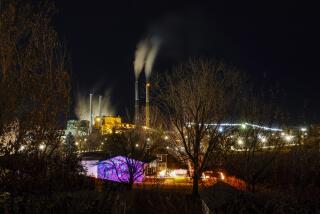Town fights hard times by cashing in on feud : Officials hope the Hatfield-McCoy battle and 1920s coal wars will draw tourists to Matewan, W. Va.
- Share via
MATEWAN, W. Va. — More than a century after the feuding Hatfields and McCoys gave mountain folk a bad name with their long, bloody battles, the struggling community where much of the fighting took place finally has decided to stop feeling ashamed.
This scruffy town, pressed hard against the Kentucky border in the most economically depressed section of a battered state, has begun to embrace unsavory aspects of its history in an effort to come to terms with the past and, in the process, maybe make a few bucks.
That history includes not only the legendary Hatfield-McCoy feud, which has been recounted and distorted time and again in movies and books, but also the bloody coal wars of the 1920s, which one historian called America’s largest armed insurrection after the Civil War.
The labor rebellion started with a 1920 shootout on the streets of tiny Matewan, but for decades folks hereabouts didn’t talk about it much.
“I was born here, and I was 28 before I even heard about any of this stuff,” said Margaret Casey, who owns a store downtown. “Somebody said something about the Matewan massacre, and I said: ‘Matewan what?’
“I knew some of the folks who were tried (for murder), but as long as a grandparent (who was involved) or Uncle So-and-so lived, nobody talked.”
“Many people were embarrassed by that part of our history,” said C. Paul McAllister Jr., who directs the Matewan Development Center. It took John Sayles’ 1987 film “Matewan” to legitimize the labor discord and bring it out into the open.
In the 1950s, there was a local effort to attract tourists here by capitalizing on the famous Hatfield-McCoy feud, which either began because of Civil War tensions, because a Hatfield stole a hog from the other clan in 1878, because a Hatfield impregnated a McCoy maiden, or a combination of all three. But members of the two families, sensitive about the hillbilly stereotypes, stopped the marketing bid dead in its tracks.
Efforts are proceeding now, said Robert W. McCoy Jr., a descendant and former mayor who sits on the development center’s board, because enough time has passed that the family members who objected “are all dead and gone.”
The 3 1/2-year-old center is restoring historic buildings with the help of grants and planning what McAllister calls the “virtual reinvention” of Matewan.
A reinvention is called for because there is not much here. The area has suffered through 33 floods in the last 35 years. Much of the town has washed away.
In this part of the state, dwindling towns cling to the hills like ticks to a half-dead cur. In some neighboring counties, coal companies have gone out of business, causing communities to campaign for prisons, nuclear waste repositories, trash dumps--anything to generate jobs.
Here in Mingo County, the mines are as productive as ever--the coal trucks that clog the snaking two-lane highways attest to that. But, because of advanced technology, they provide fewer jobs.
The development center is restoring the core of downtown. The Army Corps of Engineers plans to begin building a flood wall this year to protect what is left of the town from the waters of the Tug Fork of the Big Sandy River. Once that is complete, new development can begin.
“We’re almost starting off with a clean slate,” McAllister said. “We’ll have the historic district, and everything else downtown will be rebuilt.”
Also, proposed new highways will grant easier access to the isolated town of 619 people, which now is reachable only by driving miles along winding mountain roads.
Still, despite the isolation, McAllister said the town’s history attracts 1,000 people a year who come here even though there is nothing to see.
Stan Kaminski and George Whitmore, two college students, drove three hours on their Christmas break to get here from nearby Princeton, W. Va. “We were talking coming out here about how these are all almost ghost towns now,” Kaminski said. He said the area gave him an “eerie feeling.”
Alice Carter and Rob Weise, two other students, visited the same day. They grew up in Charleston, W. Va. and are graduate students studying Appalachian history, but they said they’d never heard of the coal wars before Sayles’ movie.
McCoy, acknowledging the “tremendous needs” in southern West Virginia, said nobody expects tourism to cure the town’s ills, “but we hope to make that a part of our economic mix. . . . The galling thing is that the Hatfield-McCoy feud is so popular, but we haven’t been able to capitalize on it. Everybody knows something about it.”
“We’re not doing this all for tourism,” he added. “It’s for our self-esteem as much as anything.”
There has always been a problem in Appalachia with how people viewed themselves, and that has limited what they were able to accomplish, he said. “We need to embark on a campaign like the blacks did in the 1960s. You know, ‘black is beautiful.’ We need to say we’re important to the history of this country. Your job is important. Your father was important. You’re not dumb hillbillies.”
More to Read
Sign up for Essential California
The most important California stories and recommendations in your inbox every morning.
You may occasionally receive promotional content from the Los Angeles Times.










